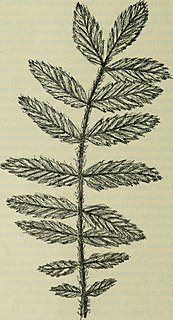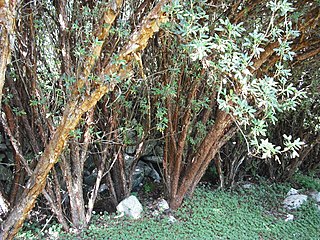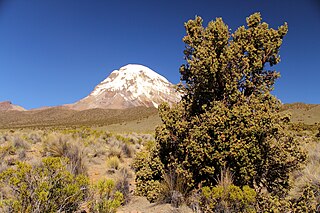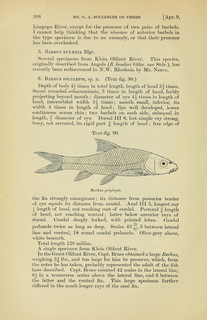
The royal cinclodes is a passerine bird which breeds in the Andes of south-east Peru and adjacent Bolivia. It was formerly considered to be a subspecies of the stout-billed cinclodes C. excelsior. It is 20 cm long and weighs 50 g with a heavy bill and dark chocolate-brown on the body, face and crown with whitish mottling and streaking on the breast.

Polylepis is a genus comprising 28 recognised shrub and tree species, that are endemic to the mid- and high-elevation regions of the tropical Andes. This group is unique in the rose family in that it is predominantly wind-pollinated. They are usually gnarled in shape, but in certain areas some trees are 15–20 m tall and have 2 m-thick trunks. The foliage is evergreen, with dense small leaves, and often having large amounts of dead twigs hanging down from the underside of the canopy. The name Polylepis is, in fact, derived from the Greek words poly (many) plus letis (layers), referring to the shredding, multi-layered bark that is common to all species of the genus. The bark is thick and rough and densely layered for protection against low temperatures. Some species of Polylepis form woodlands growing well above normal tree line within grass and scrub associations at elevations over 5000 m; which makes Polylepis appear to be the highest naturally occurring arboraceous angiosperm genus in the world.
Anabarilius polylepis is a species of ray-finned fish in the family Cyprinidae, that is endemic to Yunnan, China. It only occurs in Dian Lake and Songhuaba reservoir in Kunming. It was once a major commercial fish species, but it has not been confirmed in the lake since the 1970s. Its decline is attributed to many factors: introduced fish species, decreasing water quality, the loss of macrophytes, over-fishing, and the loss of breeding sites due to siltation and blocked access.

The Iberian nase is a species of freshwater fish in the family Cyprinidae. It is found in Portugal and in Spain. Its natural habitats are rivers and intermittent rivers.

The many-scaled cylindrical skink is a species of skink in the family Scincidae. It is found in Morocco and Western Sahara. Its natural habitats are temperate forests, temperate shrubland, Mediterranean-type shrubby vegetation, rocky areas, sandy shores, and pastureland. It is threatened by habitat loss.
Polylepis crista-galli is a species of plant in the family Rosaceae. It is endemic to Bolivia. It is threatened by habitat loss.
Polylepis hieronymi is a species of plant in the family Rosaceae. It is found in Argentina and Bolivia. It is threatened by habitat loss.

Polylepis incana is a species of plant in the family Rosaceae. It is found in Ecuador, Peru, and possibly Colombia. It is threatened by habitat loss.
Polylepis lanuginosa is a species of plant in the family Rosaceae. It is endemic to Ecuador.

Polylepis multijuga is a species of plant in the family Rosaceae. It is endemic to montane forests in the Peruvian Northern Andes, between 2700 and 3600 meters above sea level. It is threatened by habitat loss.
Polylepis neglecta is a species of plant in the family Rosaceae. It is endemic to Bolivia. It is threatened by habitat loss.
Polylepis pauta is a species of plant in the family Rosaceae. It is found in Ecuador and Peru. It is threatened by habitat loss.

Polylepis racemosa is a species of small tree in the family Rosaceae. It is endemic to Peru, Bolivia, and Ecuador. It is threatened by habitat destruction. The International Union for Conservation of Nature has assessed the conservation status of this tree as "vulnerable".

Polylepis rugulosa, the queñua, is a species of plant in the family Rosaceae. It is primarily found in the Andes region of South America in Argentina, Bolivia, Chile and Peru. It is currently threatened by habitat loss.
Polylepis subsericans is a species of plant in the family Rosaceae. It is endemic to Peru. It is threatened by habitat loss.

Polylepis tomentella, known in its native habitat by the Spanish common name queñoa de altura, is a short tree or shrub which is found in small, scattered groupings along the mountainous borders of Bolivia, Chile, and Peru, growing in soil formed by volcanoes. Populations may also be present in Argentina, but this is unconfirmed.
Polylepis weberbaueri is a species of plant in the family Rosaceae. It is found in Ecuador and Peru. It is threatened by habitat loss.

The smallscale yellowfish is a South African species of freshwater fish in the cyprinid family. It is native to the Limpopo, Incomati and Pongolo drainages.

Queuñacocha or Hatun Queuñacocha is a small lake in the Urubamba mountain range of the Cusco Region, Lares District, Calca Province, Peru. The lake lies north of Chicón, Sirihuani and Parorjo and southwest of Quisuarani, at an altitude of about 4,170 m. It is 200 metres (660 ft) long, and 140 metres (460 ft) wide at its widest point. West of it there is another small lake called Quellacocha.

The many-scaled gecko is a species of lizard in the family Gekkonidae. It is endemic to western Madagascar.












